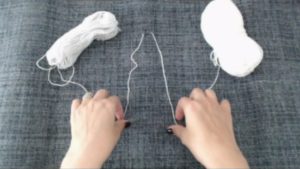
Today I want to show you how I join a new yarn in the middle of knitting project. Why? Because I got angry, and let me tell you.
I happened to over hear a discussion about how to join or attach new yarn in the middle of your work. A novice knitter was asking someone more experienced, how to do it. And her answer amazed me.
I practically drop my jaw on the floor…
Instead of talking to her about the easiest way to do it, she held a lecture of multiple advanced techniques available. I hardly kept myself quiet (as I know it’s not nice to eavesdrop, but they were talking about knitting you know). It really made me think though.
Have you noticed that there are a lot of how to tutorials and technique videos about knitting? And have you noticed that techniques showed, are more and more complicated? I mean – it looks like the more complicated stuff we can throw in, more cooler we look…
Well – we are scaring beginners people…
So, here is my super special and fancy technique. Furthermore, this is the ultimate technique we, Estonians, use in our sensationally loopy Estonian lace. And, I personally use it everywhere.
Here’s how you join new yarn in the middle of knitting in 3 easy steps:
1. Make sure you have enough yarn end left over (about 10 cm / 4 inches)

2. Make a knot

3. Make another knot

Pull it closed and done!

You can knit those yarn ends into your work as you move on or you can thread those in with a needle.




For me it depends on the yarn and project. I wouldn’t use this method for lace, it will show out.
actually it won’t – after blocking there’s nothing showing
Thank you very much. I usually use double yarn without using a knot. Have never tried the join requiring saliva-simply looks gross to me.
You could use water instead!
The Russian method is so much easier and leaves no ends to knit i. Easily googled on the net.
I like your method,square knot & weave in the ends, as you say, it is quick, easy, works for yarn and thread of all sizes, and rarely shows once ends are woven in. (It is also how manufacturers of yarn deal with the issue.
I like the idea of the Russian method for finer yarns, but haven’t gotten the hang of it, but find it takes more time and effort, and it doesn’t work on threads.
Thanks for sharing your ideas on knitting. I am an advanced crocheter and a novice knitter and the tips you share are most appreciated.
Thank you, Diane! Naturally, there are multiple ways of doing things, but it doesn’t have to be complicated. 🙂
Hi, I have attracted a few frowns using this method but so what, it works for me.
🙂 me too
I am chuckling over your comments and method. Yes, that’s what I did as a beginner, and it wasn’t scary. I did move on from it in most cases, but there are places where it is not only practical but also desirable. Good on you!
Thanks for confirming what I tried on my own last week….just want to add that if you are not a writer by trade, you should be. Loved your introduction. It’s always nice to read something in a way that makes me smile. Lynne
I am knitting a sweater that uses two colors of yarn. Color one is blue (one ball of yarn), the center panel is white and a different knitting pattern (ball number two), and blue (ball number three) from the center panel to the end of the row. I understand how to change colors as shown above, but how do I change the yarn to the third ball.? I’ll try using the same technique as shown above; perhaps that will work. I would appreciate hearing from you if there is a better way to do it.
Wendy
I can’t really tell without the picture, but if the “carry on” technique isn’t possible (different colors of panels) then maybe you could use multiple balls of yarn.
It’s hard to describe – let’s say you have 3 panels for the front of the sweater. Panel 1 – is blue, panel 2 is white and blue, and panel 3 is blue. Then you would have 1 ball of blue yarn per panel 1, 1 ball of white yarn and 1 ball of blue yarn per panel 2, and 1 ball of blue yarn per panel 3. As you move from one panel to another, you would just twist yarns. Let me try to describe it. Let’s say you’re finishing with panel 1 (blue) and want to move on with panel 2, and the next color would be white. You have blue and white next to each other. Then you would bring your blue yarn around the white yarn and back to its place. You kind of do a loop with the blue yarn around white yarn. You’ll continue with the white and blue stays to panel 1. This way the yarns are binding panel 1 and panel 2.